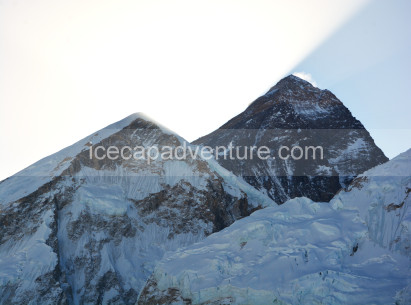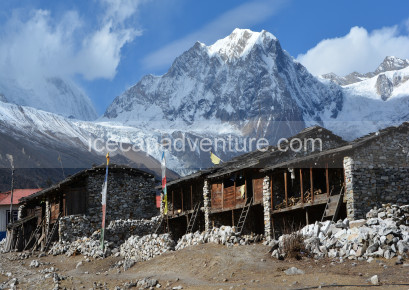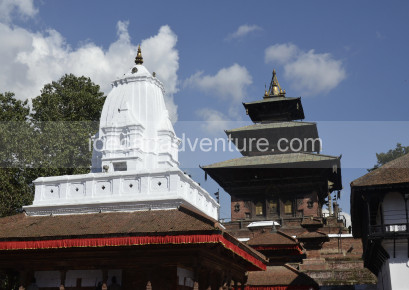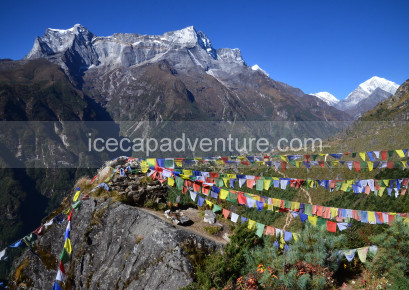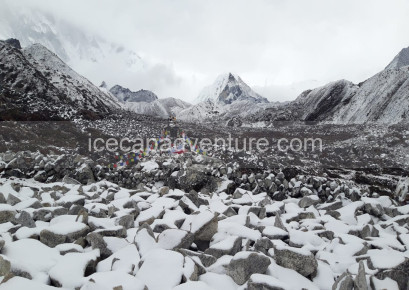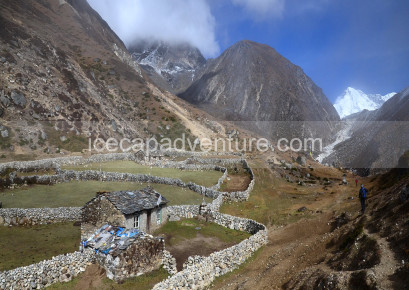.png)
.png)
.png)
.png)
.png)
.png)
.png)
.png)
The Island Peak is a stunning trekking peak located in Nepal, celebrated for its breathtaking beauty. Standing at an elevation of 6,189 meters, Island Peak Climbing has emerged as the preferred option for climbers due to its remarkable landscapes and rich cultural experiences. The journey is further enhanced by spectacular views of iconic mountains, including Mt. Everest, Lhotse, Ama Dablam, and Makalu, making the expedition both enchanting and memorable. This thrilling adventure in the Everest Region provides sweeping vistas of the unspoiled Himalayan landscape. Along the route to Island Peak, trekkers will traverse various Sherpa villages, offering numerous opportunities to delve into the history, culture, and way of life of the local communities.
The inspiring journey commences with an exhilarating flight to Lukla, followed by a trek through the picturesque Khumbu Region, visiting locations such as Phakding, Namche Bazaar, Tengboche, Pheriche, Lobuche, and Gorakshep. Trekking through these charming villages allows for an appreciation of the unique beauty found in the mountain settlements. Additionally, trekkers will have the opportunity to explore Everest Base Camp and ascend to Kala Patthar, where they can marvel at the stunning snowy peaks. Reaching the summit of Island Peak and taking in the panoramic views of the surrounding mountains is an experience that is both rewarding and unforgettable.
Optimal Timing for Climbing Island Peak:
Island Peak offers an exhilarating adventure for enthusiasts. The prime seasons for this endeavour are spring (March to May) and autumn (September to December. These periods are characterised by moderate weather, dry trails, and unobstructed mountain vistas, making them the most favourable times for climbers.
During these seasons, adventurers can enjoy breathtaking views of iconic peaks such as Everest, Lhotse, Ama Dablam, Makalu, and Pumori, among others. Moreover, the clear skies and bright sunshine enhance the stunning scenery of lush hills and deep valleys, contributing to a refreshing experience in the mountainous region. The crisp air and invigorating atmosphere further elevate the enjoyment of the trekking and climbing journey.
Climbing Island Peak can present additional challenges if weather conditions are unfavourable. However, the stability and pleasantness of the weather during spring and autumn significantly reduce these difficulties. With mild temperatures and dry trails, navigation becomes more manageable. Furthermore, the likelihood of unexpected weather events, such as heavy rain or snow, is minimised during these seasons, allowing for safer passage through steep terrain. For many trekkers, the primary objectives are to witness breathtaking views, engage in remarkable exploration, and achieve a successful ascent. Therefore, it is strongly advised to undertake this journey during the spring and autumn months.
Island Peak Summit Day:
The journey commences with a scramble along a rocky ridge leading to a glacier. At the top of this rugged terrain, climbers encounter a steep snow headwall that leads directly to the summit. Our highly trained climbing guides are adept at securing ropes, and we employ jumars and harnesses to navigate the more demanding sections of Island Peak. The ascent of the steep face, approximately 200 meters high, presents a significant challenge. Upon reaching the summit, climbers are rewarded with stunning views of the Himalayas. To the north, one can observe the impressive peaks of Nuptse and Lhotse, while the east reveals the magnificent sights of Makalu (8475 m) and Baruntse (7129 m). In the southern direction, the famous summit of Amadablam (6812 m) can be seen. Although the day is filled with challenges, it also brings a profound sense of achievement. The entire climb, including the return to base camp, typically takes around 10 hours.
What is the success rate of the Island Peak Climb?
The likelihood of successfully reaching the summit of Island Peak generally falls between 80% and 85%. Several factors influence this success rate, including weather conditions, personal fitness levels, acclimatisation processes, and thorough preparation. Climbers who adhere to the planned itinerary, engage in sufficient preparation, and ascend with an experienced guide are more likely to achieve their goal. Additionally, the overall capability of the group to manage both physical and mental challenges at high altitudes plays a crucial role in determining success.
Major Highlights of Island Peak Climbing:
- Scenic flight to and from Lukla -
- Trek through picturesque Sherpa villages
- Engage with the lifestyle of the local inhabitants of the Khumbu Region
- Opportunity to explore Namche Bazaar
- Visit Tengboche Monastery -
- Breathtaking views of the pristine Khumbu Icefall
- Panoramic vistas of mountains, including Mount Everest, Lhotse, Ama Dablam, Makalu, Nuptse, Island Peak, Cho Oyu, Thamserku, Pumori, Baruntse, and many others.
1
We will be waiting to welcome you at Tribhuvan International Airport, Kathmandu, where you will be greeted with a traditional Nepali flower garland to mark your arrival. After the warm welcome, we will drive you to your hotel—approximately 30 minutes during the day and 20 minutes at night.
Upon reaching the hotel, you will be offered welcome drinks and biscuits, followed by the settlement of your rooms. Once settled, please join us back in the lobby or meeting hall for a briefing about your trekking and tour program on the Island Peak Climbing, including an introduction to your trekking guide and other relevant details. After the briefing, you will have the opportunity to check your trekking equipment with your guide.
Note: If you arrive in Kathmandu at night, these activities will be scheduled for the following day after breakfast and meals.
.png)
.png)
.png)
.png)
3
After an early breakfast, you will take a scenic flight from Kathmandu (or Hille, via connecting arrangements) to Lukla, landing at an altitude of 2,800 meters (9,186 ft). The flight offers breathtaking views of the Himalayan peaks, including Everest, Lhotse, and Nuptse, making it one of the most spectacular aerial journeys in the world. Upon arrival in Lukla, you will meet your trekking guide and porter team and begin the trek to Phakding, which takes about 3 to 4 hours. The trail follows the Dudh Koshi River, passing through pine forests, small villages, and suspension bridges. Phakding is a quaint village with traditional teahouses, providing the perfect first night of acclimatization in the Everest region.
Highlights of the Day:
-
Spectacular flight from Kathmandu/Hille to Lukla with panoramic Himalayan views
-
Trek along the Dudh Koshi River with scenic villages and suspension bridges
-
Experience local Sherpa culture in teahouses along the trail
-
Arrival in Phakding, a charming village ideal for acclimatization
.png)
.png)
.png)
.png)
3
After breakfast in Phakding, the trek continues along the Dudh Koshi River, gradually ascending towards Namche Bazaar, the bustling Sherpa hub of the Everest region. The hike takes approximately 5 to 6 hours and passes through several traditional villages, dense pine forests, and multiple suspension bridges over roaring rivers. The trail offers stunning views of Thamserku, Kusum Kanguru, and Kongde peaks. Arriving in Namche Bazaar at 3,440 meters (11,283 ft), you’ll find a lively town full of shops, bakeries, and teahouses, making it the perfect place to rest, acclimatize, and enjoy the vibrant Sherpa culture.
Highlights of the Day:
-
Scenic trek along the Dudh Koshi River with multiple suspension bridges
-
Panoramic views of Thamserku, Kusum Kanguru, and Kongde peaks
-
Arrival in Namche Bazaar, the cultural and trading center of the Khumbu region
-
Opportunity to explore local shops, bakeries, and experience Sherpa culture
.png)
.png)
.png)
.png)
4
Today is a rest and acclimatization day in the vibrant town of Namche Bazaar, allowing your body to adjust to the higher altitude before continuing the trek. After breakfast, you can take short hikes to nearby viewpoints such as the Everest View Hotel, offering breathtaking panoramas of Everest, Lhotse, Nuptse, and Ama Dablam. The day also provides the opportunity to explore Namche Bazaar’s markets, bakeries, and local culture, including traditional Sherpa homes and monasteries. Proper acclimatization helps reduce the risk of altitude sickness and prepares you for the more challenging days ahead.
Highlights of the Day:
-
Short hikes to nearby viewpoints with panoramic views of Everest, Lhotse, Nuptse, and Ama Dablam
-
Exploration of Namche Bazaar’s vibrant market and local culture
-
Visit to monasteries and traditional Sherpa settlements
-
Rest and acclimatization for a safe continuation of the trek
.png)
.png)
.png)
.png)
5
After breakfast, you will leave Namche Bazaar and begin the trek towards Tengboche, known for its famous monastery and panoramic Himalayan views. The hike takes approximately 5 to 6 hours and includes a combination of uphill climbs and gradual descents through rhododendron and pine forests. Along the way, you’ll pass small Sherpa villages and enjoy increasing views of iconic peaks such as Ama Dablam, Everest, Lhotse, and Nuptse. Arriving in Tengboche at 3,867 meters (12,684 ft), you can visit the Tengboche Monastery, one of the most important spiritual centers in the Khumbu region, and soak in the serene mountain ambiance.
Highlights of the Day:
-
Trek through scenic forests and traditional Sherpa villages
-
Panoramic views of Everest, Lhotse, Nuptse, and Ama Dablam
-
Visit to the historic Tengboche Monastery
-
Immersive experience of Sherpa culture and mountain spirituality
.png)
.png)
.png)
.png)
6
After breakfast at Tengboche, the trek continues toward Dingboche, a picturesque village in the Imja Valley, taking approximately 5 to 6 hours. The trail gradually ascends through alpine meadows, moraine valleys, and scattered stone villages, offering spectacular views of Ama Dablam, Lhotse, and Island Peak. You’ll pass through small settlements where you can observe traditional Sherpa life and livestock grazing. Arriving in Dingboche at 4,358 meters (14,295 ft), you will settle into a teahouse and take time to rest and acclimatize for the higher altitude trekking days ahead.
Highlights of the Day:
-
Trek through scenic alpine valleys and traditional Sherpa villages
-
Stunning mountain vistas including Ama Dablam, Lhotse, and Island Peak
-
Opportunity to experience local culture and high-altitude village life
-
Arrival in Dingboche with time for acclimatization and rest
.png)
.png)
.png)
.png)
7
After breakfast in Dingboche, you will take a short but scenic trek to Chhukung Valley, which takes approximately 2 to 3 hours. The trail gently ascends through moraine landscapes and alpine meadows, offering panoramic views of Island Peak (Imja Tse), Lhotse, and Ama Dablam. Chhukung Valley is a high-altitude settlement serving as a base for climbers attempting Island Peak, and it provides excellent acclimatization opportunities. Upon arrival at 4,730 meters (15,518 ft), you can rest and explore the surrounding valley, preparing your body for higher altitude trekking in the following days.
Highlights of the Day:
-
Short trek through alpine meadows and moraine landscapes
-
Panoramic mountain views including Island Peak, Lhotse, and Ama Dablam
-
Arrival in Chhukung Valley, a key acclimatization and trekking base
-
Opportunity to experience high-altitude Sherpa settlements and culture
.png)
.png)
.png)
.png)
8
After breakfast in Chhukung, you will begin the trek toward Island Peak Base Camp, located at 5,200 meters (17,060 ft). The trek takes approximately 3 to 4 hours along a rocky moraine trail with gradual elevation gain, offering spectacular views of Island Peak (Imja Tse), Lhotse, and Ama Dablam. This short but challenging trek helps climbers further acclimatize before attempting the summit. Upon arrival at Base Camp, you can rest, explore the surrounding glacial landscape, and prepare for technical climbing or further acclimatization as required.
Highlights of the Day:
-
Trek through high-altitude moraine and glacial terrain
-
Panoramic views of Island Peak, Lhotse, and Ama Dablam
-
Arrival at Island Peak Base Camp, a key acclimatization and climbing hub
-
Opportunity to experience high-altitude Himalayan environment and preparation for summit climb
.png)
.png)
.png)
.png)
9
After an early breakfast at Island Peak Base Camp, you will begin the trek to High Camp, located at 5,600 meters (18,372 ft). The hike takes approximately 2 to 3 hours along steep, rocky, and occasionally icy terrain, offering breathtaking views of Island Peak, Imja Glacier, Lhotse, and Ama Dablam. This short but demanding trek is designed to further acclimatize your body for the summit attempt, allowing climbers to adjust to higher altitudes while experiencing dramatic Himalayan landscapes. Upon arrival at High Camp, you can rest, hydrate, and prepare for the early morning summit climb.
Highlights of the Day:
-
Trek through steep moraine and glacier terrain with stunning mountain vistas
-
Panoramic views of Island Peak, Lhotse, Ama Dablam, and surrounding glaciers
-
Arrival at High Camp, the key staging point for the Island Peak summit
-
High-altitude acclimatization in preparation for summit climb
.png)
.png)
.png)
.png)
10
After a very early breakfast at High Camp, you will begin the summit climb of Island Peak, reaching the top at 6,189 meters (20,305 ft). The ascent takes 4–5 hours, depending on conditions and pace, along steep snow and ice slopes using crampons and fixed ropes. The summit offers unparalleled panoramic views of the Everest region, including Lhotse, Makalu, Ama Dablam, and the surrounding glaciers. After celebrating the achievement, you will carefully descend back to High Camp and continue trekking down to Chhukung for rest and recovery. The total day, including ascent and descent, lasts approximately 8–10 hours.
Highlights of the Day:
-
Summit of Island Peak at 6,189m, one of the most iconic Himalayan climbs
-
Spectacular panoramic views of Lhotse, Makalu, Ama Dablam, and the surrounding peaks
-
High-altitude mountaineering experience with snow and ice climbing
-
Descent to Chhukung for rest and recovery, completing a rewarding adventure
.png)
.png)
.png)
.png)
11
After breakfast in Chhukung, you will begin the descent toward Tengboche, passing through scenic alpine valleys, moraine trails, and small Sherpa villages. The trek takes approximately 4 to 5 hours and provides stunning views of Ama Dablam, Lhotse, and Island Peak along the way. Arriving at Tengboche at 3,867 meters (12,684 ft), you can visit the famous Tengboche Monastery, one of the most significant spiritual centers in the Khumbu region. This descent allows your body to recover from higher altitudes while still enjoying the breathtaking Himalayan landscape.
Highlights of the Day:
-
Trek through alpine valleys and traditional Sherpa villages
-
Panoramic views of Ama Dablam, Lhotse, and Island Peak
-
Visit to Tengboche Monastery, a major spiritual site in the Everest region
-
Descent provides opportunity for acclimatization and recovery after high-altitude climb
.png)
.png)
.png)
.png)
12
After breakfast at Tengboche, you will begin the descent to Namche Bazaar, retracing part of the trail along forests, suspension bridges, and traditional Sherpa villages. The trek takes approximately 4 to 5 hours and offers renewed perspectives of the Himalayan peaks, including Ama Dablam, Thamserku, and Kongde. Arriving in Namche Bazaar at 3,440 meters (11,283 ft), you can enjoy a leisurely afternoon exploring the bustling market town, relaxing in a teahouse, or visiting local bakeries and monasteries. This descent helps your body recover from higher altitudes while providing scenic views along the route.
Highlights of the Day:
-
Trek through pine and rhododendron forests with suspension bridges
-
Stunning views of Ama Dablam, Thamserku, and Kongde peaks
-
Arrival in Namche Bazaar, a vibrant Sherpa cultural hub
-
Opportunity to explore local shops, monasteries, and bakeries
.png)
.png)
.png)
.png)
13
After breakfast in Namche Bazaar, you will begin the final leg of the trek, descending toward Lukla. The trek takes approximately 6 to 7 hours, passing through forests, terraced fields, rivers, and several Sherpa villages along the way. Enjoy stunning Himalayan views, including Thamserku, Kongde, and other surrounding peaks, while descending gradually to the lower altitude of Lukla. Upon arrival at 2,800 meters (9,186 ft), you’ll check into a teahouse or lodge, marking the completion of your trekking journey.
Highlights of the Day:
-
Scenic descent through forests, terraced fields, and traditional Sherpa villages
-
Panoramic views of Thamserku, Kongde, and surrounding Himalayan peaks
-
Completion of the trek with arrival in Lukla
-
Opportunity to rest and celebrate the trekking accomplishment
.png)
.png)
.png)
.png)
14
After breakfast at Lukla, you will take a scenic flight back to Kathmandu, which lasts approximately 35–40 minutes. The flight offers spectacular aerial views of the Himalayan peaks, deep valleys, and snow-capped summits, providing a final panoramic perspective of the Everest region. Upon arrival in Kathmandu at 1,300 meters (4,264 ft), you will be transferred to your hotel for rest and relaxation. The afternoon can be spent exploring the city, shopping for souvenirs, or enjoying a leisurely walk through Thamel and nearby attractions.
Highlights of the Day:
-
Scenic mountain flight with breathtaking Himalayan views
-
Return to Kathmandu from the Everest region
-
Opportunity for last-minute shopping and city exploration
-
Relaxation after the trekking adventure
.png)
.png)
.png)
.png)
15
On the final day of your journey, after breakfast at your hotel, you will be transferred to Tribhuvan International Airport, Kathmandu, for your onward flight. Depending on your flight schedule, you may have some free time to do last-minute shopping, sightseeing, or enjoy a final stroll through Thamel. Airport assistance will be provided to ensure a smooth and hassle-free departure. As you leave Kathmandu, you will carry unforgettable memories of your trekking and climbing adventure in the Himalayas.
Highlights of the Day:
-
Transfer to Tribhuvan International Airport for departure
-
Opportunity for last-minute shopping or sightseeing in Kathmandu
-
Reflection on your trekking and climbing experiences
-
Smooth airport formalities and assisted departure
.png)
.png)
2
Before embarking on the thrilling Island Peak (Imja Tse, 6189m) Climbing expedition, a dedicated shopping and preparation day in Kathmandu is essential. This day ensures that all climbers have the right gear, supplies, and permits for a safe and successful trek and summit attempt.
During this day, climbers can purchase or double-check essential high-altitude equipment, including insulated jackets, climbing boots, crampons, harnesses, helmets, ice axes, gloves, and down clothing. Local trekking and mountaineering shops provide quality gear and expert advice, making sure that every item meets high-altitude and safety standards.
In addition to shopping, this day allows you to organize luggage, pack expedition kits, and review climbing permits and documentation. Your guides may also provide briefings about the Island Peak route, weather considerations, acclimatization schedule, and safety protocols, ensuring you are fully prepared physically, mentally, and logistically for the climb ahead.
Highlights of the Day
-
Check and purchase high-altitude trekking and climbing gear
-
Organize and pack personal and expedition equipment
-
Review permits, documentation, and safety guidelines
-
Attend briefings about Island Peak route, weather, and acclimatization
-
Mental and physical preparation for the upcoming expedition
.png)
.png)
.png)
.png)

Didn’t find what you were looking for?
So why not plan your own trip. It takes only 2 minutes.- Airport arrival and departure by private vehicle
- 3 star accommodation in Kathmandu with breakast for two nights
- Kathmandu to Lukla to Kathmandu both way flight tickets
- Meal on full board (breakfast, lunch, dinner, tea & coffee)basis during the trek
- Accommodation on tented camp during Climbing period
- Trekking/Island peak Climbing peak permit/s & other necessary fees
- Climbing guide, cook & necessary Sherpa helper, all payments
- Exclusive medical kit bag
- All government and local taxes
- Submit your tourist registration form to the require embassy/consulate
- Visa fees, intl. airfare & departure taxes
- Personal climbing equipment (can be hire in Kathmandu)
- Excess baggage charges
- Lunch and dinner in city
- Travel and rescue insurance
- Personal expenses e.g. phone calls, laundry, bar bills & extra porters
- Tips for driver, guides and porters

✅ Clothing
-
Base Layers (Thermal Tops & Bottoms)
-
Trekking Shirts (Long & Short Sleeves)
-
Fleece Jacket / Warm Mid-layer – For insulation.
-
Down Jacket – Essential for nights above 3,500m.
-
Waterproof & Windproof Jacket (with hood).
-
Trekking Pants (lightweight, quick-drying).
-
Warm Trekking Pants (for high altitude).
-
Waterproof Pants (for rain/snow).
-
Underwear – Comfortable, quick-dry.
-
Sports Bras (for women).
✅ Head & Hand Wear
-
Warm Hat / Beanie and Sun Hat / Cap.
-
Buff / Neck Gaiter / Scarf.
-
Sunglasses and Gloves 2 pairs
✅ Footwear
-
Trekking Boots – Sturdy, waterproof, broken-in.
-
Lightweight Shoes / Sandals – For camp/teahouse.
-
Warm Trekking Socks – At least 4–5 pairs.
✅ Sleeping & Bags
-
Sleeping Bag (Down -15°C) and Liner.
-
Duffel Bag (carried by porter).
-
Daypack (30–40L) – For personal items.
-
Rain Cover for Backpack.
✅ Trekking Gear
-
Trekking Poles & Gaiters – For snow or muddy.
-
Headlamp (with extra batteries).
-
Water Bottles (2–3 liters) and Water Purifications.
-
Personal First Aid Kit
-
Snacks / Energy Bars / Dry Fruits.
✅ Accessories & Personal Items
-
Sunscreen (SPF 30–50) and Lip Balm with SPF.
-
Toiletries and Hand Sanitizer.
-
Towel (quick-dry) and Toilet Paper
-
Camera / Power Bank / Solar Charger.
✅ Documents & Money
-
Valid Passport and Visa.
-
Travel Insurance (cover high-altitude & helicopter rescue).
-
Cash (Nepali Rupees) – For personal expenses.
Good to Know – Island Peak Climbing
-
Best Seasons to Climb:
The Island Peak Expedition (Imja Tse, 6,189m) is best attempted during spring (March–May) and autumn (September–November). These seasons offer stable weather, clear skies, and safer climbing conditions. Winter brings extreme cold and snow, while the monsoon (June–August) makes trails slippery and increases avalanche risk. -
Altitude Awareness:
Island Peak is a high-altitude trekking peak, reaching 6,189 meters. Proper acclimatization is essential to prevent acute mountain sickness (AMS). Trekkers should ascend gradually and include rest or acclimatization days in Namche Bazaar, Dingboche, or Chhukung. -
Physical Fitness:
The climb is moderate to challenging, suitable for trekkers with good fitness levels and some prior trekking experience. Daily climbs range from 5–8 hours, including glacier travel, steep snow slopes, and sections requiring basic mountaineering techniques. -
Permits Required:
Climbers need an Island Peak Climbing Permit and a Sagarmatha National Park Permit, obtainable through licensed trekking or expedition operators. A TIMS card is also required for the trekking section. -
Accommodation and Meals:
Accommodation along the trek is in teahouses and lodges, while Base Camp and higher camps use tents. Meals include dal bhat, noodles, soups, pasta, and energy snacks. At higher camps, food is limited and more expensive. -
Drinking Water:
Water is generally available in villages or melted from snow at higher camps. Trekkers should carry a reusable bottle with purification tablets or filters. Staying hydrated is crucial at high altitude. -
Packing and Gears:
Essential gear includes trekking boots, crampons, ice axe, harness, helmet, gloves, warm layered clothing, down jacket, trekking poles, sleeping bag rated for -15°C, sunglasses, sunscreen, headlamp, power bank, and personal first aid kit. Technical climbing gear is required for the summit. -
Transportation and Route:
The trek usually begins with a flight from Kathmandu to Lukla, then trekking through Namche Bazaar, Tengboche, Dingboche, and Chhukung to Island Peak Base Camp. Climbers establish a high camp on the glacier before attempting the summit. The route passes glaciers, alpine terrain, and stunning Himalayan vistas. -
Travel Insurance:
Comprehensive high-altitude trekking and climbing insurance is strongly recommended, covering medical emergencies, helicopter evacuation, and climbing risks. -
Connectivity and Charging:
Mobile signals are available in larger villages like Namche Bazaar and Dingboche, but limited at higher camps. Charging facilities are available at some lodges for a small fee; carrying a power bank is essential. -
Highlight Experience:
Island Peak offers a challenging yet accessible mountaineering experience with panoramic views of Everest, Lhotse, Ama Dablam, and Makalu. It’s ideal for trekkers seeking a high-altitude summit adventure with basic technical climbing, providing a great introduction to Himalayan mountaineering.

